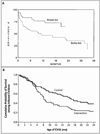Immunology of pediatric HIV infection
- PMID: 23772619
- PMCID: PMC3737605
- DOI: 10.1111/imr.12074
Immunology of pediatric HIV infection
Abstract
Most infants born to human immunodeficiency virus (HIV)-infected women escape HIV infection. Infants evade infection despite an immature immune system and, in the case of breastfeeding, prolonged repetitive exposure. If infants become infected, the course of their infection and response to treatment differs dramatically depending upon the timing (in utero, intrapartum, or during breastfeeding) and potentially the route of their infection. Perinatally acquired HIV infection occurs during a critical window of immune development. HIV's perturbation of this dynamic process may account for the striking age-dependent differences in HIV disease progression. HIV infection also profoundly disrupts the maternal immune system upon which infants rely for protection and immune instruction. Therefore, it is not surprising that infants who escape HIV infection still suffer adverse effects. In this review, we highlight the unique aspects of pediatric HIV transmission and pathogenesis with a focus on mechanisms by which HIV infection during immune ontogeny may allow discovery of key elements for protection and control from HIV.
© 2013 John Wiley & Sons A/S. Published by John Wiley & Sons Ltd.
Conflict of interest statement
The authors have no conflicts of interest to declare.
Figures








References
-
- Rates of mother-to-child transmission of HIV-1 in Africa, America, and Europe: results from 13 perinatal studies. The Working Group on Mother-To-Child Transmission of HIV. J Acquir Immune Defic Syndr Hum Retrovirol. 1995;8:506–510. - PubMed
-
- Adams KM, Nelson JL. Microchimerism: an investigative frontier in autoimmunity and transplantation. JAMA. 2004;291:1127–1131. - PubMed
Publication types
MeSH terms
Grants and funding
- UM1 AI068632/AI/NIAID NIH HHS/United States
- R01 HD 39611/HD/NICHD NIH HHS/United States
- AI 100147/AI/NIAID NIH HHS/United States
- R01 HD 57617/HD/NICHD NIH HHS/United States
- R01 HD 40777/HD/NICHD NIH HHS/United States
- R01 HD057617/HD/NICHD NIH HHS/United States
- UM1 AI106716/AI/NIAID NIH HHS/United States
- U01 AI068632/AI/NIAID NIH HHS/United States
- R01 HD039611/HD/NICHD NIH HHS/United States
- R01 HD040777/HD/NICHD NIH HHS/United States
- U01 AI 68632/AI/NIAID NIH HHS/United States
- R01 AI100147/AI/NIAID NIH HHS/United States
- AI 68632/AI/NIAID NIH HHS/United States
LinkOut - more resources
Full Text Sources
Other Literature Sources
Medical

